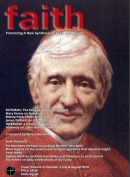Cutting Edge
Dr Gregory Farrelly FAITH MAGAZINE March - April 2015
Catholics and Science
An interesting and rather unusual article by Richard de Grijs in the January edition of Physics World concerns the Jesuit mission in China in the late 16th century. Fr Matteo Ricci (1552-1610) was the Jesuit missionary famed for his linguistic, mathematical, musical and cartographic skills; it was he who produced the first known map of China. Johann Adam Schall von Bell was a Jesuit who became the imperial astronomer.
De Grijs, writing as a non-believer in a secular journal, has this to say about them: “Despite their underlying aim of converting the local population to Christianity, many of these priests were genuinely interested in a two-way exchange of information.”
This is, to my mind, at the heart of the apostolate of the Faith movement. As Catholics we need to engage in works of love with our fellow men and women in this secular, anti-Catholic world, but we also need to exercise an intellectual apostolate, one that must begin with the sort of two-way exchange that the Jesuits undertook in China.
Having listened to the views of secular or lapsed Catholic acquaintances, we should be able to give a defence of our faith that shows that natural science itself implies a belief in a fundamentally meaningful, ordered universe, and that the Catholic church has itself played a part in the development of scientific thought.
In the first half of 2015, Pope Francis is expected to produce an encyclical concerning the environment; it will be the first major teaching document by a pontiff to be dedicated exclusively to ecology. The aim is to influence world policies, such as those to be drafted this September at the United Nations meeting on sustainable development.
Bishop Marcelo Sánchez Sorondo, chancellor of the Pontifical Academy of Sciences, recently said that Pope Francis wants to convene a summit of faith leaders to discuss ecological issues after the encyclical comes out.
Beagle 2
The late Professor Colin Pillinger, of the Open University, was somewhat ridiculed when his pet project, the Beagle 2 mission to land a small space probe on Mars, appeared to have failed on Christmas Day 2003. In January this year, it was announced that the lander had been identified in images taken by Nasa’s Mars Reconnaissance Orbiter in 2013; these showed the lander as a glinting object, just a few pixels wide, about 5km from the intended touchdown site. The images can be seen at https://www.esa.int/Our_Activities/Space_Science/Mars_Express/Beagle-2_lander_found_on_Mars.
It seems that some of the solar panels failed to open, either because of a faulty motor or because the craft was damaged by an unlucky bounce. As a result the radio antenna was unable to work and so no signals could be sent back to Earth. Describing what had happened, Professor Mark Sims of Leicester University, who was Beagle 2’s mission manager, said: “It’s like dropping a tin of baked beans and denting it, and then trying to get the lid off.”
Pillinger had hoped that the probe, named after HMS Beagle, the expedition ship of Charles Darwin, would bring about a “quantum leap” in our knowledge of Mars, just as Darwin had forever changed our understanding of life on Earth. The mission was largely funded by private donations and money from unconventional promotional campaigns led by Pillinger. Beagle 2 was supposed to sample rocks and soil, seeking out signs of life by looking for carbon signatures in a similar way to Philae on the Rosetta mission.
During pre-mission tests, the probe’s air bags had burst and the landing parachute had to be redesigned. The European Space Agency (ESA) considered not allowing Beagle 2 on board its Mars Express mission, yet Pillinger was a persuasive, indomitable figure.
However eccentric he was, and whatever one’s view of the wisdom of such “small” missions (Beagle 2 cost a mere £66m, compared with the $1.6bn which Nasa spent on its Mars Reconnaissance Rover), Pillinger’s enthusiasm to find out if there is evidence of alien life is a sign of the intellectual curiosity that lies at the heart of all good science. As noted in previous editions of this column, this intellectual characteristic is spiritual. The spiritual soul has the properties of intellect and will, knowledge and love.
Stephen Fry’s Diabolical Worm
Stephen Fry’s video, railing against a God who can permit a worm “whose whole life cycle is to burrow into the eyes of children and make them blind” has become viral. In fact, the African Loa loa worm in question affects very few humans (not that this mitigates the suffering). What Fry did not state is that diethylcarbamazine has been shown as an effective preventive for this infection.
This example is, indeed, a problem for creationists, who view all creatures as uniquely and individually created and designed by God, without evolution. The Faith movement’s perspective is, rather, that the “laws” of nature are a result of God’s Unity-Law in matter; they have their own dynamic and evolve in time and space, resulting in living and non-living things that, from a human perspective, may be harmful or beneficial.
Unlike other animals, however, we have a God-given intellect that enables us to use our scientific understanding of these laws to prevent, alleviate and sometimes cure disease.
Dr Gregory Farrelly is a physics teacher at Cambridge Tutors College, Croydon.


